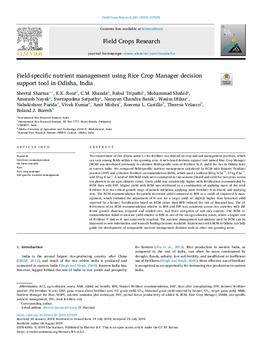Mostrar el registro sencillo del ítem
Field-specific nutrient management using Rice Crop Manager decision support tool in Odisha, India
| Autor: | Sharma, S. |
| Autor: | Rout, K.K. |
| Autor: | Khanda, C.M. |
| Autor: | Tripathi, R. |
| Autor: | Shahid, M. |
| Autor: | Nayak, A.D. |
| Autor: | Satpathy, S.D. |
| Autor: | Banik, N.C. |
| Autor: | Iftikar, W. |
| Autor: | Parida, N. |
| Autor: | Kumar, V. |
| Autor: | Mishra, A. |
| Autor: | Castillo, R.L. |
| Autor: | Velasco, T. |
| Autor: | Buresh, R.J. |
| Año: | 2019 |
| ISSN: | 0378-4290 |
| URI: | https://hdl.handle.net/10883/20564 |
| Resumen: | The requirement of rice (Oryza sativa L.) for fertilizer can depend on crop and soil management practices, which can vary among fields within a rice-growing area. A web-based decision support tool named Rice Crop Manager (RCM) was developed previously to calculate field-specific rates of fertilizer N, P, and K for rice in Odisha State in eastern India. We compared field-specific nutrient management calculated by RCM with farmers’ fertilizer practice (FFP) and a blanket fertilizer recommendation (BFR), which used a uniform 80 kg N ha–1, 17 kg P ha–1, and 33 kg K ha–1. A total of 209 field trials were conducted in two seasons (kharif and rabi) for two years across ten districts in six agro-climatic zones. Grain yield was consistently higher with fertilization recommended by RCM than with FFP. Higher yield with RCM was attributed to a combination of applying more of the total fertilizer N at the critical growth stage of panicle initiation, applying more fertilizer N in kharif, and applying zinc. The RCM recommendation frequently increased yield compared to BFR as a result of improved N management, which included the adjustment of N rate for a target yield set slightly higher than historical yield reported by a farmer. Fertilization based on RCM rather than BFR reduced the risk of financial loss. The effectiveness of an RCM recommendation relative to BFR and FFP was consistent across rice varieties with different growth duration, irrigated and rainfed rice, and three categories of soil clay content. The RCM recommendation failed to increase yield relative to BFR in one of the six agro-climatic zones, where a higher rate of fertilizer P and/or K was apparently required. The nutrient management calculations used by RCM can be improved as new information and research findings become available. Experiences with RCM in Odisha can help guide the development of comparable nutrient management decision tools in other rice-growing areas. |
| Formato: | |
| Lenguaje: | English |
| Editor: | Elsevier |
| Copyright: | CIMMYT manages Intellectual Assets as International Public Goods. The user is free to download, print, store and share this work. In case you want to translate or create any other derivative work and share or distribute such translation/derivative work, please contact CIMMYT-Knowledge-Center@cgiar.org indicating the work you want to use and the kind of use you intend; CIMMYT will contact you with the suitable license for that purpose. |
| Tipo: | Article |
| Lugar de publicación: | Amsterdam (Netherlands) |
| Páginas: | art. 107578 |
| Volumen: | 241 |
| DOI: | 10.1016/j.fcr.2019.107578 |
| País: | INDIA |
| Agrovoc: | FERTILIZERS |
| Agrovoc: | ON-FARM RESEARCH |
| Agrovoc: | RICE |
| Agrovoc: | SITE SPECIFIC NUTRIENT MANAGEMENT |
| Datasets relacionados: | https://ars.els-cdn.com/content/image/1-s2.0-S0378429019301935-mmc1.docx |
| Revista: | Field Crops Research |
Ficheros en el ítem
Este ítem aparece en la(s) siguiente(s) colección(ones)
-
Sustainable Intensification
Sustainable intensification agriculture including topics on cropping systems, agronomy, soil, mechanization, precision agriculture, etc.

